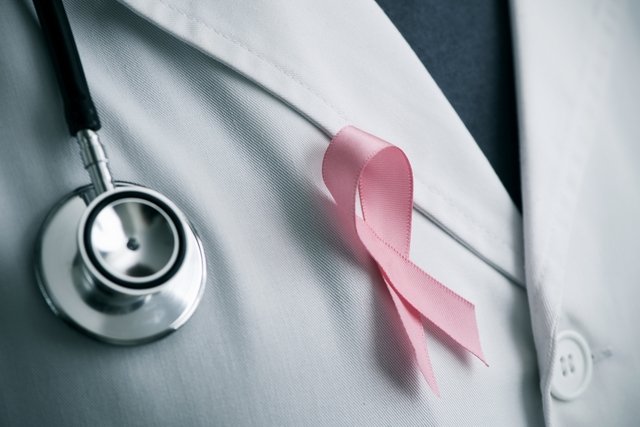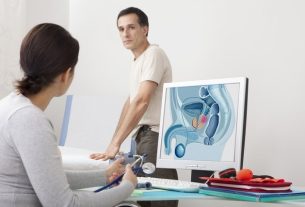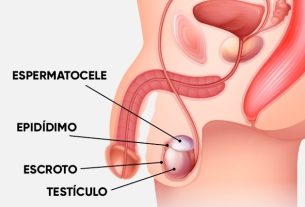Male breast cancer is rare, but when it appears, it is more common between the ages of 50 and 65, especially when there are cases of breast or ovarian cancer in the family.
Despite being more common in women, breast cancer can also develop in men, as they also have the mammary gland and female hormones in lower concentrations. However, the diagnosis is usually late, as the symptoms are not intense and preventive exams are not usually carried out.
The treatment of male breast cancer is similar to the treatment of breast cancer in women, with surgery and chemotherapy being indicated. However, as the diagnosis is most often late, the cure rate tends to be lower.

Main symptoms
Symptoms of breast cancer in men include:
- Nodule or lump in the chest, behind the nipple or just below the areola, which does not cause pain;
- Nipple facing inward;
- Pain in a specific area of the chest that appears some time after the nodule appears;
- Wrinkled or wavy skin;
- Outflow of blood or liquid through the nipple;
- Redness or peeling of the skin of the breast or nipple;
- Changes in breast volume;
- Swelling of the armpits.
Most cases of breast cancer do not have easy-to-identify symptoms and, therefore, men with cases of breast cancer in the family should alert their breast specialist to have regular exams after the age of 50 to diagnose changes that could indicate cancer.
Don’t ignore your symptoms!
How to confirm the diagnosis
The diagnosis of male breast cancer must be made by a mastologist, through tests such as mammography, breast ultrasound and biopsy. In addition, the doctor may also recommend blood tests, especially genetic tests, chest X-ray, bone scintigraphy and tomography, to check the extent of the disease. See the main tests used to identify breast cancer.
These exams are important to check whether the changes identified are, in fact, breast cancer, as they may be benign changes, as is the case with gynecomastia, in which there is greater development of male breast tissue. Furthermore, changes may also indicate the presence of benign tumors, such as fibroadenoma, which is normally confined to the breast tissue and does not represent a risk.
Types of breast cancer in men
The types of male breast cancer can be:
- Carcinoma ductal in situ: cancer cells form in the breast ducts, but do not invade or spread outside the breast and are almost always curable with surgery;
- Invasive ductal carcinoma: reaches the wall of the duct and develops through the glandular tissue of the breast. It can spread to other organs and represents 80% of tumors;
- Invasive lobular carcinoma: grows in the lobe of the breast and corresponds to the rarest type in men;
- Paget’s disease: starts in the breast ducts and causes nipple crusting, scales, itching, swelling, redness and bleeding. Paget’s disease may be associated with ductal carcinoma on site or with invasive ductal carcinoma;
- Inflammatory breast cancer: it is very rare in men and consists of inflammation of the breast that causes swelling, redness and burning, as opposed to forming a nodule;
It is not known exactly what can cause breast cancer in men, but some factors that seem to contribute are advanced age, previously benign breast disease, testicular disease and chromosomal mutations, such as Klinefelter Syndrome, in addition to the use of anabolic steroids or estrogens, radiation, alcoholism and obesity.
How the treatment is carried out
Treatment for breast cancer in men varies according to the degree of development of the disease, but generally begins with surgery to remove all affected tissue, including the nipple and areola, a procedure called mastectomy, as well as the inflamed tongue.
When the cancer is very developed, it may not be possible to remove all the cancer cells and, therefore, it may still be necessary to undergo other treatments such as chemotherapy, radiotherapy or hormonal therapy, with tamoxifen, for example.
Is male breast cancer curable?
There are greater chances of cure when cancer is discovered early, however, cancer is often discovered at a more advanced stage, reducing the chances of cure.
The size of the nodule and the affected nodes must be taken into consideration, there is normally a lower chance of cure when the nodule is more than 2.5 cm and affects several nodes. Just like women, black men and those with mutations in the BRCA2 gene also have a lower chance of a cure.
How to increase the chances of a cure
The best way to increase the chances of a cure for male breast cancer is by identifying it at an early stage.
Therefore, it is recommended to carry out breast self-examination regularly, in the same way that women do it, with the aim of identifying lumps or changes in the breast that could be an early sign of cancer. Find out how breast self-examination is done.
Bibliography
- AMERICAN CANCER SOCIETY. What Is Breast Cancer in Men?. Disponível em: <https://www.cancer.org/cancer/breast-cancer-in-men/about/what-is-breast-cancer-in-men.html>. Acesso em 23 out 2019
- GOLDMAN, Lee; SCHAFER, Andrew I.. Goldman-Cecil Medicina. 25 ed. Rio de Janeiro: Elsevier, 2018. 1378-1386.
- WEBMD. Breast Cancer in Men. Available at: <https://www.webmd.com/breast-cancer/breast-cancer-men>. Accessed on October 23, 2019
- NATIONAL BREAST CANCER FOUNDATION. Male Breast Cancer. Available at: <https://www.nationalbreastcancer.org/male-breast-cancer>. Accessed on October 23, 2019

Sign up for our newsletter and stay up to date with exclusive news
that can transform your routine!
Warning: Undefined array key "title" in /home/storelat/public_html/wp-content/plugins/link-whisper-premium/templates/frontend/related-posts.php on line 12
Warning: Undefined array key "title_tag" in /home/storelat/public_html/wp-content/plugins/link-whisper-premium/templates/frontend/related-posts.php on line 13



